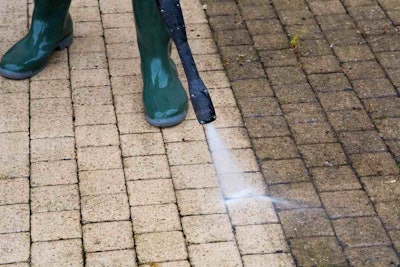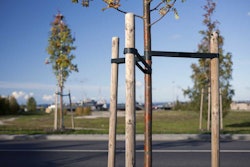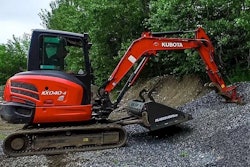
Just as you’ve had to iterate to clients that low-maintenance plants do not mean no maintenance, hardscapes still need care to keep them looking their very best.
There are three main ways to maintain your customer’s hardscapes and make sure their aesthetic value doesn’t dwindle.
Repair
As time goes on, wear and tear can occur and cracked concrete or stones should be replaced. Homeowners will probably point out these problems to you, but commercial clients may not be aware of these issues, which is why having regular property checkups can help you catch complications before they become something more serious.
Settlement can occur when there is inadequate soil or base compaction and pavers can move apart if edge restraints are loose. Yet this can be easily fixed by removing the pavers and adjusting the settlement, preventing wasted paving material.
Clean
Cleaning hardscapes annually is important as hard stains and fading can decrease the value of a property. To keep a neat appearance, first remove any weeds that have taken up residence in the cracks. Weed inhibitor can be sprayed to keep them from sprouting in the first place.
Before starting any cleaning project, it is important to determine if the hardscape has been sealed or not as certain types of cleaners will strip the sealant. Spot cleaning stains from substances like oil or grease should be done before the overall cleaning.
Stains should generally be treated as soon as possible, otherwise they will penetrate deeper and become harder to remove. Liquid detergent should be applied and allowed to soak to remove stains from ketchup or grease drippings. The paver should be scrubbed and rinsed with hot water immediately afterwards. For stains that are particularly stubborn, it can be easier to replace the stained pavers with new ones.
Once the stains are taken care of you can do an overall cleaning of the hardscape. This can be done with some serious elbow grease or a pressure washer, but take care when using the pressure washer.
Pressure washing can be harmful to the paving if done incorrectly, so start a low pressure and work your way up. Spray at a shallow angle that isn’t parallel to the joints, as this can cause the pavers to become dislodged. This sort of thorough cleaning is good for removing efflorescence and should be done before sealing the surface.
Seal
Sealing pavers can help protect them from the elements and stains. They can also help intensify a pavement’s colors as some offer a glossy sheen and others create a matte finish.
Sealer should be applied when the surface has been cleaned and dry. The temperature should be between 50 and 80 degrees, with no forecast of rain in the next 24 hours. Sprinklers that may spray the surface should also be shut off.
Depending on the sealant used, it may need to be applied yearly or it will vary based on the use, climate and quality of the sealer. Even with a sealed hardscape it is still important to keep it clean regularly. If these types of tasks seem too much for your client, you can always offer to handle the job for them, adding on a new element to your business.









